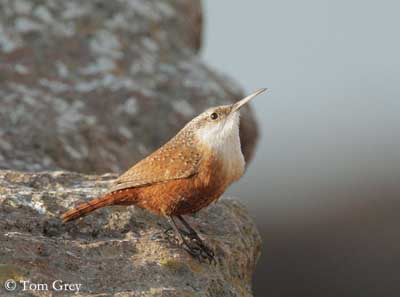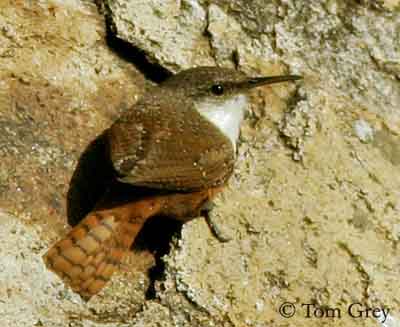
Canyon Wren
Catherpes mexicanus
Passeriforme Order – Troglodytidae Family
BIOMETRICS:
Length : 11 à 15 cm
Wingspan : 19 cm
Weight : 10 à 18 g
DESCRIPTION:
Canyon Wren is a small songbird. It has brown chestnut plumage on upperparts, finely spotted with white. Underparts are rusty chestnut. Belly is chestnut with fine black and white spots. Rufous flanks are slightly barred with black. Rufous tail is finely barred with black. Chin, throat and upper breast are white.
Head is brownish-grey, with fine spots forehead, crown and nape. Lower face is white. Head is relatively small and flattened.
Long greyish bill is slender and decurved. Eyes are dark brown to black. Legs and large feet are blackish.
DIET:
Canyon Wren feeds mainly on invertebrates, insects and spiders. It is not known to drink water. All its needs are probably got from its food.
PROTECTION / THREATS / STATUS:
Canyon Wren is vulnerable to low temperatures, and it may occur some declines in severe winters. It is relatively common within its habitat, but recreational rock climbing by humans may disturb nesting areas.
Fr: Troglodyte des canyons
All : Schluchtenzaunkönig
Esp : Ratona de los Cañones
Ital : Scricciolo dei canyon
Nd : Kloofwinterkoning
Russe : Каньонный крапивник
Sd : Kanjongärdsmyg
Photographs by Tom Grey
His website:
Tom Grey's Bird Pictures
Text by Nicole Bouglouan
Sources:
HANDBOOK OF THE BIRDS OF THE WORLD Vol 10 by Josep del Hoyo-Andrew Elliott-David Christie - Lynx Edicions - ISBN: 8487334725
WRENS, DIPPERS AND THRASHERS by Brewer David – illustrated by Barry Kent Mackay- Yale University Press - ISBN: 0300090595
BIRDS OF THE GREAT BASIN – by Fred A. Ryser - Univ of Nevada Pr -ISBN: 0874170796
A GUIDE TO THE BIRDS OF MEXICO AND NORTHERN CENTRAL AMERICA by Steve N. G. Howell, Sophie Webb - Oxford University Press - ISBN: 0198540124
All About Birds (Cornell Lab of Ornithology)
Bird Web (Seattle Audubon Society)

BEHAVIOUR:
Canyon Wren gleans from rocky surfaces to find its food. Its long thin bill and its flattened head make easy to search insects and spiders between stones and rock crevices. It may probes deeply into holes and narrow crevices. It also forages through dense undergrowth and thickets, rarely on the ground.
Canyon Wren is well adapted to its environment. It can climb up and down, and walk across rocks, thanks to its low centre of gravity, its large feet and its sharp claws. Canyon Wren sometimes performs flycatching to seize insects. This bird is often seen creeping like a mouse around rocks, or as a Wall creeper. It presses its body close to the rock, but doesn’t use its tail as a prop.
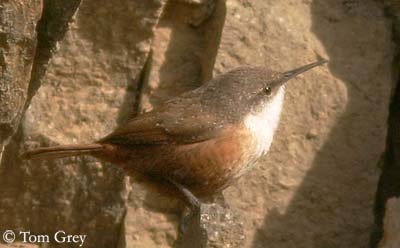
Both sexes are similar, with male slightly larger than female.
Juvenile resembles adults, but upperparts are more uniform than in adults, and flanks lack black bars.
We can find two subspecies:
C.m. mexicanus, or Mexican Canyon Wren, from Mexico. It is larger and darker than previous.
C.m. albifrons, or Giraud’s Canyon Wren, or White-throated Canyon Wren, from northern Mexico to South West Texas. It is paler and greyer on upperparts than “mexicanus”, with paler underparts too, and fine bars on tail feathers.
VOICE: SOUNDS BY XENO-CANTO
Canyon Wren utters a loud silvery song, a decelerating series of liquid “tees” and tews”, a strong series of whistles continuously descending in pitch. Call is a metallic buzz.
Canyon Wren’s song is often heard in the canyons of western United States.
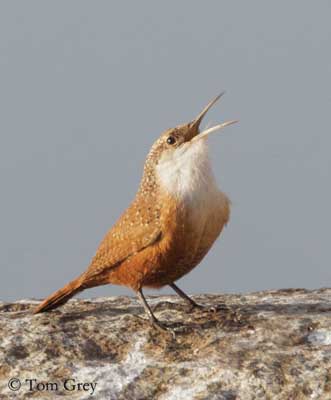
HABITAT:
Canyon Wren lives in canyons and cliffs, rocky areas and boulder piles, in arid regions. It is also found around buildings, especially those made of stones, but it prefers the base of a canyon wall. We can find this species from sea level to 9800 feet, near water, although it doesn’t drink water.
RANGE:
Canyon Wren lives from southern British Columbia, throughout United States, and southwards to Mexico.
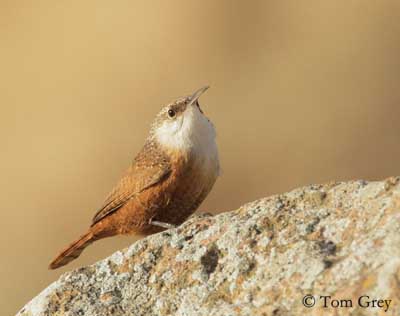
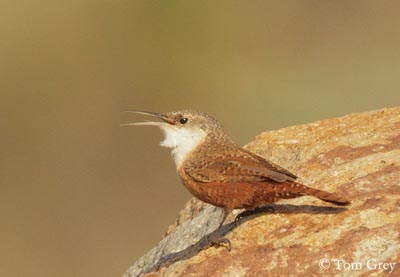
FLIGHT:
Canyon Wren performs a weak and fluttering direct flight, with shallow wing beats. It makes frequent short flights from rock to rock, and longer flight across canyons.
REPRODUCTION:
Canyon Wren’s nest is situated in crevices, rock caverns, holes, cliffs or banks. Cup-shaped nest is built under a ledge, in order to protect it. Both male and female build the nest. Base is made with twigs, sticks, bark and grasses. Interior is lined with softer materials such as lichens, plant down, wool, feathers and fur. They frequently add some debris.
Female lays 4 to 7 white eggs, speckled with reddish-brown. Incubation lasts about 12 to 18 days, by female. Incubation starts when the last egg is laid. Male feeds female during this period. Altricial chicks are fed by both parents. They fledge at about 10 days after hatching, and young are able to feed themselves, foraging with their parents.
Canyon Wren is solitary nester, and may produce two broods per year.
